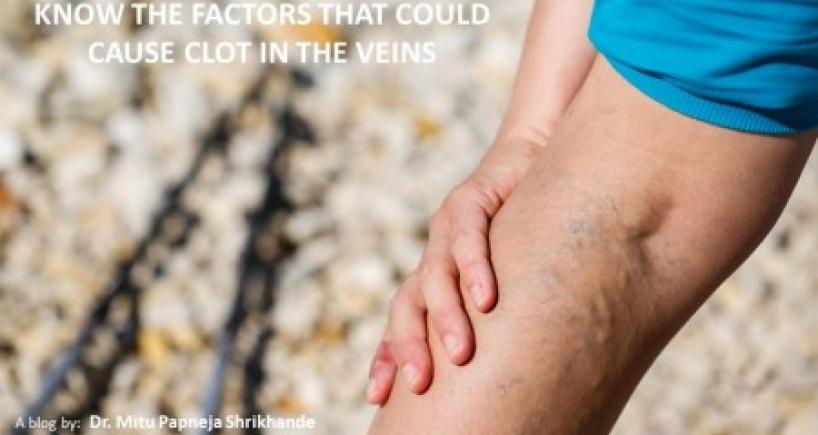
Haematology
Know The Factors That Could Cause Clot In The Veins
Dr. Mitu Shrikhande Oct 17, 2019
 When a clot forms in the deep veins of the body, it is called deep vein thrombosis (DVT). DVT occurs most commonly in the leg; although it can also occur anywhere including the veins in the arm, abdomen or the brain. The symptoms of DVT include pain, swelling, warmth, swelling, and discoloration (bluish, purplish or reddish skin color). Symptoms may range from mild to severe. Symptoms may also be subtle and confused with other medical conditions, such as a pulled muscle or sprained ankle or cellulitis.
Pulmonary embolism (PE) is a potentially life-threatening complication of DVT. PE occurs when a clot breaks off and travels through the heart into the pulmonary circulation. The symptoms include shortness of breath, chest pain, unexplained increased heartrate or unexplained cough. Symptoms vary in severity and may mimic a lung infection or Asthma.
The risk factors for venous thrombosis:
Immobility, surgery, post-trauma, bone fractures, intake of Contraceptive pills, pregnancy, cancer, chemotherapy, heart failure, autoimmune disorders, kidney disorders, varicose veins, smoking, obesity, old age and previous or family history of DVT.
Tips for Preventing DVT and PE:
When a clot forms in the deep veins of the body, it is called deep vein thrombosis (DVT). DVT occurs most commonly in the leg; although it can also occur anywhere including the veins in the arm, abdomen or the brain. The symptoms of DVT include pain, swelling, warmth, swelling, and discoloration (bluish, purplish or reddish skin color). Symptoms may range from mild to severe. Symptoms may also be subtle and confused with other medical conditions, such as a pulled muscle or sprained ankle or cellulitis.
Pulmonary embolism (PE) is a potentially life-threatening complication of DVT. PE occurs when a clot breaks off and travels through the heart into the pulmonary circulation. The symptoms include shortness of breath, chest pain, unexplained increased heartrate or unexplained cough. Symptoms vary in severity and may mimic a lung infection or Asthma.
The risk factors for venous thrombosis:
Immobility, surgery, post-trauma, bone fractures, intake of Contraceptive pills, pregnancy, cancer, chemotherapy, heart failure, autoimmune disorders, kidney disorders, varicose veins, smoking, obesity, old age and previous or family history of DVT.
Tips for Preventing DVT and PE:
- Stay active. Immobility increases the risk of developing clots. During long-distance travel, stay well hydrated and take a break to
- Maintain ideal body weight.
- Don’t smoke.
- Know your risk factors for developing a clot.
- Know your family’s medical history.
- Post surgeries and during hospitalization, blood clot prevention measures should be taken.
- If you have symptoms of DVT or PE, seek medical attention. Prompt diagnosis and treatment can prevent many complications.
Categories
Clear allMeet the doctor

Dr. Mitu Shrikhande
DIRECTOR HEMATO-ONCOLOGY & BMT | Fortis Vasant Kunj
- Haematology | Haematology
-
21 Years
-
1800
















